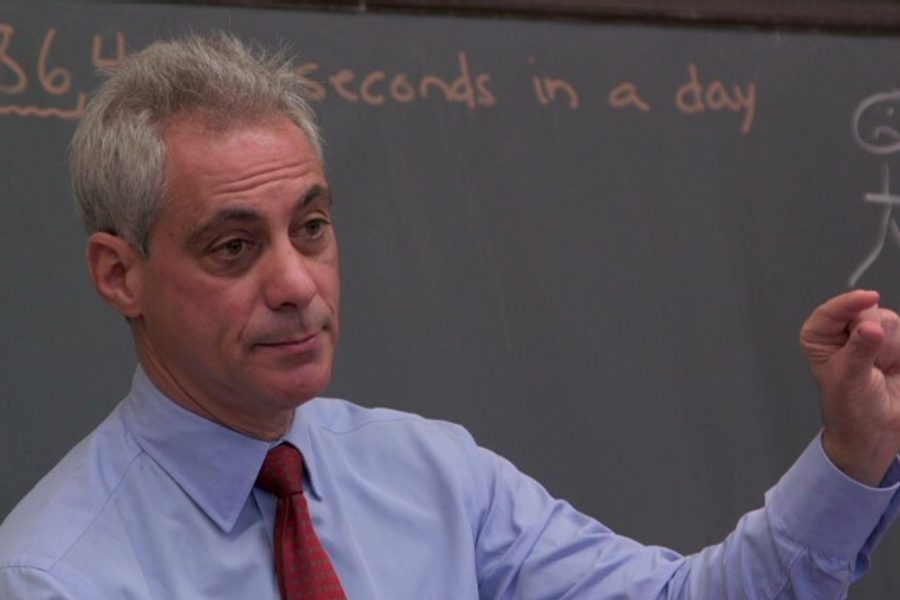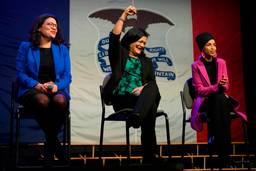Chicagoland, Episode 5: Startups vs. Shootouts
The latest episode of the CNN miniseries ultimately lets Mayor Rahm Emanuel off the hook for Chicago’s rifts.
Kari Lydersen

There is a world where you worry about whether drinking regular or diet soda will have a bigger effect on your sex life.
And there is a world where you worry about whether you will make it through the first day of school without being shot.
Both of these worlds exist within 20 miles of each other in Chicago, as the ongoing CNN docudrama series Chicagoland shows viewers this week.
Chicago is often described as a “tale of two cities.” There’s the North Side, full of glistening skyscrapers, tree-lined streets, Gold Coast mansions, trendy sidewalk cafes and nightclubs. Then there are the burned-out buildings, overgrown lots, barred windows, trash barrel fires and menacing street corners of the South and West Sides.
Chicagoland has invoked the “two cities” leitmotif repeatedly throughout the series, which is currently on its fifth episode. But in this week’s installment, airing tonight, the trope is on particularly vivid display as filmmakers contrast preparations for the first day of school at Fenger High in the Roseland neighborhood and for the “Demo Day” startup extravaganza downtown.
In Roseland, on the city’s South Side, staff, students and heroic principal Liz Dozier are worrying about threats of gang bloodshed and about city, state and federal budget cuts that threaten the very survival of their school. Downtown, digital startup entrepreneurs are sweating it out as they prepare to unveil their online dating, weight loss and branding ventures for an audience of potential investors.
As school staff weighs the odds of lethal gang violence breaking out in Roseland, a startup team stresses out because their guy is botching his pitch about the fact that Diet Coke drinkers have four times more sex than those who quaff regular Coke.
The dissonance is jarring and almost comical, especially given that Mayor Rahm Emanuel has framed high-tech and digital startups as the bedrock of an economically thriving and globally significant “new Chicago.” A new venture, he says, launches every 24 hours, and the technology sector as a whole has brought thousands of new jobs to the city. The startup revolution may be revamping parts of Chicago; but as Chicagoland vividly shows, vast stretches of the city remain structurally crumbling and socially distressed.
Filmmakers Marc Levin and Mark Benjamin say Chicagoland is a social justice project in the same vein as their previous, often award-winning, work. Levin’s films include treatments of the Triangle Shirtwaist Factory Fire and the L.A. riots; Benjamin’s wide-ranging resume encompasses the film version of performance artist-activist Danny Hoch’s Jails, Hospitals and Hip-Hop and extensive collaborations with Bill Moyers. In Chicago, they’re turning their cameras on a major American city that is making the transition from a manufacturing-based economy to an information-based one. In the process, though, it’s leaving many people behind.
“Chicago is known as the city that works — the city of working people. And the history of the labor movement is all so ingrained” in Chicago’s history, Levin tells me as I talk with the pair halfway through Chicagoland’s eight-week run. “Chicago always venerated the blue-collar worker and it’s always been a union town,” he says. But now, when industry has dwindled, the labor movement has withered and unemployment has risen, he says, “that is changing.”
With state and national capitols politically paralyzed, Levin says, Chicagoland is exploring the question of whether a mayor like Emanuel can make a difference on a metropolitan level. Can he, Levin wonders, use the brute force of his personality and his connections to solve the economic problems — and, by extension, the violence — killing many of the city’s neighborhoods?
Emanuel’s many critics believe the answer is no. They counter that his policies — slashing and privatizing public-sector jobs and services; quashing forums for community input; attacking unions — are making inequality and poverty worse, not better. They see Emanuel as more concerned with polishing his own and the city’s images than truly solving deep-seated problems. And they see Chicagoland as serving that mission all too well.
Indeed, though episode five can be read as a pointed jab at Emanuel’s “savior” startups, much of the series comes across like a slick extended campaign commercial. Upcoming episodes offer an African-American man calling out “I’m voting for you buddy!” as Emanuel dashes by him outside a school; there’s also a cloying classroom scene where the only “question” a student asks about the highly controversial school closings turns out to be a setup for Emanuel to praise his appointed school board for not closing high schools. The scenes that do criticize Emanuel almost always end with the mayor getting the last word, archly writing off his detractors without actually responding to them.
So what about the rumors that Chicagoland was Emanuel’s election-year brainchild, or that his Hollywood agent brother Ari had undue influence over the series?
Levin and Benjamin claim that neither Rahm nor Ari Emanuel had anything to do with the project’s inception. Instead, in the wake of their award-winning series Brick City about Newark under Cory Booker, profiling a quintessential American metropolis with another “rock star” mayor was a no-brainer, the filmmakers say.
However, they do admit that getting access to the mayor’s office took careful negotiation. “There is a tradeoff between access and how you handle some of these things, there’s no doubt about this,” Levin acknowledges. “Chicago literally is a city that has been locked down to media —for years — under the [former Mayors Richard M. and Richard J.] Daley Machine. There’s an opening happening in Chicago now … there’s a dance there, and City Hall is finally beginning to open up and let go.”
Meanwhile, Levin says the critics of the mayor whom they interviewed, or tried to, “were surprisingly uncooperative or resistant to opening up … almost nobody wanted to go on camera and really take on City Hall.”
Those hoping for a more incisive take on the mayor’s reign in the second stretch of the eight-part series will likely be disappointed. Starting in episode five, Chicagoland delves a bit deeper into the historical and systemic nature of the city’s urban violence and decay. It accurately notes that the murder rate was actually much higher in decades past, even though “Chiraq” has made international headlines for violence in recent years. This is important context for seriously understanding the violence issue; in Chicagoland, however, the inclusion comes off as another way to let Rahm off the hook.
Likewise, police superintendent Garry McCarthy opines to the camera that crime is rooted in deeper problems like entrenched poverty and broken families. He’s right, of course, but his demeanor and his words come off as stridently defensive, making him appear more concerned with shifting the blame away from himself and the mayor than with the tragedy he is describing.
I asked Benjamin and Levin if their reporting has led them to see to any possible solutions to Chicago’s violence and inequality. They say that beyond small bright spots like their hero Liz Dozier, they don’t foresee sweeping change any time soon.
“I’m not optimistic we’ll solve urban violence,” says Benjamin. “If a job can stop a bullet, that’s a solution,” he continues, referencing Chicagoland’s emphasis on ways to increase employment opportunities throughout the city. “But that’s not necessarily attainable in a contracting economy. That’s the nightmare.”
Meanwhile, Emanuel, brash and cocky as ever, has trumpeted incremental victories like a falling murder rate and a record high school graduation rate; recently, he’s also stepped up his outreach to the African-American community.
On March 31, the mayor gave a rousing speech at the Union League Club in downtown Chicago at a seminar called “The $2 Billion Question: Can Illinois Spend Less on Incarceration and Improve Public Safety?”
He promised to unite the two Chicagos, invoking the “majestic skyline” and sparkling waters of Lake Michigan, and lamenting the impoverished youth who have never been downtown or who (according to him) don’t even know they live near a lake. With all Chicago’s promise, he said, “The question we have to ask is whether that energy, that optimism, that city on a move includes them or excludes them.”
To his credit, the mayor has undertaken some concrete measures to address the epidemic of incarceration and unemployment particularly affecting Black men. At the Union League Club, he described his efforts to help pass a bill through the state legislature that would mean automatic expungement of juvenile arrest records if formal charges are never filed. Currently, people must go through a lengthy and costly process to clean their records of arrests, even if they were never actually charged. That means poor Black and Latino men in low-income neighborhoods have surely lost countless jobs, apartments or other opportunities because of arrest records that could have more to do with their violence-plagued, heavily-policed surroundings than their own behavior.
Emanuel also recently announced the imminent expansion of a city program providing transit and parks jobs to ex-offenders, as well as an initiative that starts to roll back policies barring ex-offenders from public housing.
At the seminar, Emanuel trotted out one of his signature stories, also told at length in a previous episode of Chicagoland: the time he struck up a conversation with an engaging young man named Martell Cowan at a city-sponsored basketball game, wrote a complimentary note to his mom and then gave the youth a ride home, invited him to City Hall and ultimately became his personal mentor.
Emanuel probably was truly impressed by Cowan, who landed an internship at City Hall, and the mayor’s interest surely did change the course of the young man’s life. But whether they are motivated by cold-eyed political calculus, genuine empathy or both, such individual acts of doing good can never atone for the injustices of a system where people are marked as criminals because of their looks and location alone.
While the attendees who gave Emanuel a standing ovation at the “$2 Billion” seminar may have been charmed, seasoned observers chalk the mayor’s recent focus on criminal-justice reform up to pragmatism and politics as usual. Conveniently, after all, the initiatives come just as the mayoral contest is starting to ramp up. While one poll shows Emanuel regaining ground with African-American voters, another shows him losing the race as a whole — and losing among Black voters especially — should Cook County board president Toni Preckwinkle jump in.
Skeptics also note Emanuel’s key role in the Clinton White House during the crafting and passage of the 1996 crime bill that is widely held responsible for the modern incarceration boom; he was also at Clinton’s side on the welfare reform legislation that shredded the safety net upon which many low-income Black families depended.
More recently, Emanuel was vice chair of the board of the Chicago Housing Authority in the 1990s as it drafted the sweeping and controversial “Plan for Transformation,” under which the public housing rolls were cleansed of people with criminal convictions and even their family members — the very same policies he now pledges to rein in.
If Emanuel is serious about using his clout and executive power to address incarceration impacts in the long term, even his harshest critics may be able to hold their noses and work with him. But even beginning to solve real problems like violence, disinvestment and recidivism is exponentially more difficult than the realms where Emanuel has seemingly excelled — like creating buzz around flashy startup companies or using taxpayer subsidies to lure major corporate headquarters.
Emanuel’s expansion of the ex-offender job program, for example, will offer positions and job training to 700 more formerly incarcerated people . The trial public housing program will bring just 50 ex-offenders into housing over a three-year period — and only if they are working. But some 21,000 former inmates return to Chicago each year. Hence, Emanuel’s new initiatives amount to barely a drop in the bucket.
There are of course no simple ways to revitalize communities that have been devastated by decades of disinvestment and segregation. But numerous community groups have drafted various plans and proposals for revamping schools and enhancing neighborhoods — proposals that often fall on deaf ears in the mayor’s office. Meanwhile, they say he is making the problems worse by closing schools and health clinics.
Chicagoland tells one tale showing just how hard it is to escape social and economic ruin in neighborhoods like Roseland. Principal Dozier goes to great lengths to help a former student get released from jail, only to have him fall back into the criminal street life in order to survive.
In the world of branding and venture capital in which Emanuel thrives, flashy announcements by politicians and entrepreneurs may get you funding. But as the residents of Roseland know, they don’t put food on the table.

I hope you found this article important. Before you leave, I want to ask you to consider supporting our work with a donation. In These Times needs readers like you to help sustain our mission. We don’t depend on—or want—corporate advertising or deep-pocketed billionaires to fund our journalism. We’re supported by you, the reader, so we can focus on covering the issues that matter most to the progressive movement without fear or compromise.
Our work isn’t hidden behind a paywall because of people like you who support our journalism. We want to keep it that way. If you value the work we do and the movements we cover, please consider donating to In These Times.
Kari Lydersen is a Chicago-based journalist, author and assistant professor at Northwestern University, where she leads the investigative specialization at the Medill School of Journalism, Media, Integrated Marketing Communications. Her books include Mayor 1%: Rahm Emanuel and the Rise of Chicago’s 99%.







